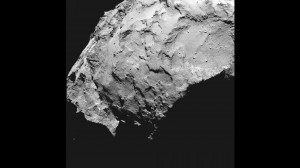Europe’s Rosetta mission to Comet 67P/Churyumov-Gerasimenko is nearing a nail-biting moment – when the Philae lander is to be unleashed for a touchdown on the celestial wanderer.
The primary landing site is landing site “J” – a spot that has relatively flat terrain and good solar illumination.
There is a detailed timetable for the descent of Philae.
On October 14, the primary landing site and the schedule will be finally confirmed or a decision made to descend on the backup landing site – landing site “C”.
If a go is given for landing site “J” the lander will undock from the Rosetta spacecraft at 09:35 Central European Time (CET) on November 12 at a distance of approximately 14 miles (22.5 kilometers) from the center of the comet and land on the surface about seven hours later.
The first confirmation of the landing is expected at around 17:00 CET.
The landing will be controlled from the German Aerospace Center (Deutsches Zentrum für Luft- und Raumfahrt; DLR) Lander Control Center (LCC) in Cologne.
If spacecraft engineers decide to use the backup site, Philae will undock from Rosetta at 14:04 CET on November 12 at a distance of only about 8 miles (12.5 kilometers) from the center of the comet.
In this case, the descent will only take about four hours. A first signal from the surface would be expected at about 18:30 CET.
The signal travel time between Rosetta and Earth is 28 minutes and 20 seconds.
“Tension is mounting,” says DLR scientist Stephan Ulamec, Project Manager for the Philae lander in a press statement.
Rosetta is a European Space Agency (ESA) mission with contributions from its member states and NASA. Rosetta’s Philae lander is funded by a consortium headed by German Aerospace Center (Deutsches Zentrum für Luft- und Raumfahrt; (DLR), the Max Planck Institute for Solar System Research (MPS), CNES and the Italian Space Agency (ASI).
By Leonard David

